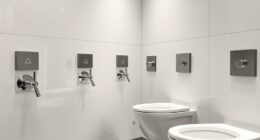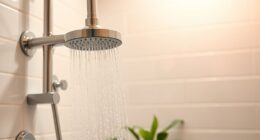Are you tired of scrubbing your bathtub endlessly, only to find stubborn stains still lingering? Look no further! In this article, we will show you how to clean your bathtub with bleach, a powerful and effective cleaning agent.
With just a few simple steps, you can say goodbye to grime and hello to a sparkling clean tub. So, grab your supplies and get ready to transform your bathroom into a pristine oasis.
Let’s dive in!
Key Takeaways
- Bleach is a powerful disinfectant that eliminates harmful bacteria, viruses, and mold.
- It is effective in removing tough stains and grime from the bathtub.
- Regularly cleaning the bathtub with bleach keeps it hygienic and free from germs.
- Proper ventilation and wearing protective gear are important when using bleach.
Why Use Bleach to Clean Your Bathtub
Using bleach in the bathroom is a great way to effectively clean your bathtub. Bleach is a powerful disinfectant that eliminates harmful bacteria, viruses, and mold that can thrive in damp environments like the bathroom. It helps keep your bathtub hygienic and free from germs. Additionally, bleach is effective in removing tough stains and grime, leaving your bathtub sparkling clean.
However, there are a few cons to consider. Bleach has a strong odor that may be unpleasant, and it can also be harmful if not used properly. It is important to use bleach in a well-ventilated area, wear protective gloves, and avoid mixing it with other cleaning products.
Overall, using bleach in your bathtub has numerous pros, but it is essential to exercise caution and follow safety guidelines.
Supplies Needed for Cleaning With Bleach
To get started, you’ll need a few supplies for the bleach cleaning method. Here is a list of the essential items you will need:
| Supplies | Quantity | Purpose |
|---|---|---|
| Bleach | 1 bottle | Powerful disinfectant and stain remover |
| Rubber gloves | 1 pair | Protect your hands from chemicals |
| Sponge | 1 | Ideal for scrubbing and applying bleach |
| Scrub brush | 1 | Helps remove tough stains and grime |
| Spray bottle | 1 | Convenient way to apply the bleach |
Using bleach for cleaning your bathtub offers several benefits. The cleaning process becomes easier as bleach effectively kills germs, eliminates mold and mildew, and removes stubborn stains. It also helps to restore the bathtub’s shine and brightness, making it look brand new. Additionally, bleach is a cost-effective solution that saves you time and effort. Now that you have the necessary supplies, you can move on to preparing the bathtub for cleaning.
Preparing the Bathtub for Cleaning
To effectively clean your bathtub, it is important to tackle two common challenges: removing soap scum and eliminating stubborn stains.
Soap scum can build up over time and create a dull, dirty appearance. By using the right cleaning products and techniques, you can easily remove soap scum and restore the shine to your bathtub.
Additionally, stubborn stains such as rust or hard water stains may require a bit more effort, but with the right approach, you can successfully eliminate them and achieve a sparkling clean bathtub.
Removing Soap Scum
Removing soap scum from your bathtub is easier with a mixture of bleach and water. Soap scum is a common problem in bathrooms and can make your bathtub look dirty and unattractive.
To eliminate the grime, create a solution by mixing one part bleach with three parts water. Dip a sponge or cloth into the solution and scrub the affected areas. The bleach will help break down the soap scum, making it easier to remove.
Rinse the bathtub thoroughly with water after scrubbing to remove any remaining residue. To prevent future soap scum buildup, make sure to regularly clean your bathtub and dry it after each use. Additionally, using a liquid shower gel instead of bar soap can help minimize soap scum.
Eliminating Stubborn Stains
If you’re struggling with stubborn stains in your bathtub, try using a mixture of vinegar and baking soda. This natural cleaning solution can effectively remove hard water stains and restore the shine to your tub.
Here are three simple steps to eliminate those pesky stains:
- Mix equal parts vinegar and baking soda to form a paste.
- Apply the paste to the stained areas of your bathtub.
- Let it sit for about 15 minutes, then scrub gently with a sponge or brush.
This vinegar and baking soda mixture is not only effective in removing hard water stains, but it is also a great way to prevent future stains. After cleaning your bathtub, make it a habit to rinse with warm water and wipe dry. This will help reduce the buildup of minerals that cause stains.
Step-By-Step Guide to Cleaning Your Bathtub With Bleach
Start by filling your bathtub with warm water and adding a cup of bleach to effectively clean it. Bleach is a powerful disinfectant that can eliminate grime and prevent mold growth in your bathtub.
Once you have added the bleach, use a sponge or a brush to scrub the entire surface of the tub. Pay extra attention to areas with stubborn stains or built-up grime.
Rinse the tub thoroughly with clean water to remove any residue. Remember to wear gloves and ensure proper ventilation while working with bleach.
Regularly cleaning your bathtub with bleach can help maintain a clean and hygienic bathroom environment.
Tips for Effective Bleach Cleaning
Using a sponge or brush, it’s important to thoroughly scrub the entire surface of your tub when cleaning with bleach. This ensures that you remove any dirt or grime that may be present.
However, it’s crucial to take certain precautions when using bleach as a cleaning agent. Here are some tips to keep in mind:
- Always wear gloves and protective eyewear to avoid direct contact with the bleach.
- Make sure the area is well-ventilated by opening windows or using fans.
- Avoid mixing bleach with other cleaning products, as this can create toxic fumes.
If you prefer to avoid using bleach, there are alternative cleaning methods you can try. Some options include using baking soda and vinegar, hydrogen peroxide, or a mixture of dish soap and warm water. These alternatives are effective in removing stains and disinfecting your bathtub without the harshness of bleach.
How Long to Let Bleach Sit on the Bathtub
To ensure maximum effectiveness, it’s best to let the bleach sit on the surface of your tub for at least 5-10 minutes before rinsing. This allows the bleach to penetrate and break down any dirt, grime, or stains on the bathtub.
When applying bleach, make sure to wear gloves and work in a well-ventilated area. Start by diluting the bleach according to the instructions on the bottle. Then, using a sponge or cloth, apply the bleach solution to the entire surface of the tub, focusing on any areas that are particularly dirty or stained.
After applying the bleach, let it sit undisturbed for the recommended waiting time. This allows the bleach to work effectively and remove stubborn stains.
Once the waiting time is up, you can move on to the next step of rinsing and drying your bathtub properly.
Rinse and Dry Your Bathtub Properly
When it comes to cleaning your bathtub with bleach, it’s important to know the most effective techniques. Using the right method can ensure a thorough clean and eliminate any stubborn stains or bacteria.
Additionally, proper rinsing after bleach cleaning is crucial to remove any residue and ensure a safe and sanitary bathing environment.
Effective Bleach Cleaning Techniques
You can achieve an effective bleach cleaning technique by mixing bleach with water in a spray bottle. Here are some tips to help you get the best results:
- Start by wearing gloves and protective eyewear to ensure your safety.
- Make sure the area is well-ventilated to avoid inhaling the strong fumes.
- Spray the bleach solution onto the surface you want to clean and let it sit for a few minutes.
- Use a scrub brush or sponge to scrub away any dirt or stains.
- Rinse the area thoroughly with water to remove any residue.
- Dry the surface with a clean towel or let it air dry.
For the best bleach cleaning products, look for ones that are specifically designed for the task and have a high concentration of bleach. Always follow the instructions on the product label and test a small area before applying it to the entire surface.
Benefits of Proper Rinsing
Properly rinsing the surface after using bleach helps to ensure that no residue or chemical traces are left behind.
There are several pros and cons when it comes to using bleach for bathtub cleaning.
On the positive side, bleach is highly effective at killing bacteria, mold, and mildew, leaving your bathtub clean and sanitized.
However, bleach can be harsh on certain surfaces and materials, such as acrylic or enamel, and may cause discoloration or damage if not used correctly.
To avoid this, it is important to follow the best practices for rinsing.
After cleaning with bleach, thoroughly rinse the bathtub with water to remove any remaining bleach residue. Pay close attention to corners, crevices, and hard-to-reach areas.
This will help ensure a safe and residue-free surface, ready for use.
Now, let’s explore some alternatives to bleach for bathtub cleaning.
Alternatives to Bleach for Bathtub Cleaning
There are other options besides bleach for cleaning your bathtub. If you prefer natural cleaning solutions or want to avoid the strong smell of bleach, here are some alternatives to consider:
-
Vinegar: Mix equal parts white vinegar and water in a spray bottle. Spray the solution onto the bathtub surface, let it sit for a few minutes, and then scrub with a brush or sponge.
-
Baking soda: Make a paste by mixing baking soda with water. Apply the paste to the bathtub and let it sit for a while. Then, scrub and rinse thoroughly.
-
Lemon juice: Squeeze fresh lemon juice onto the bathtub surface and let it sit for a few minutes. Scrub with a sponge or brush, and rinse well.
Using these bleach alternatives can effectively clean your bathtub without the harsh chemicals. However, if you decide to use bleach, it’s important to take safety precautions to protect yourself and your surroundings.
Safety Precautions When Using Bleach
When using bleach, it’s crucial to take safety precautions to protect yourself and those around you.
Proper ventilation is essential to prevent inhalation of harmful fumes, so make sure to open windows or use fans to circulate air.
Additionally, wearing protective gear such as gloves and goggles is necessary to avoid skin and eye irritation.
Proper Ventilation for Bleach
To ensure safety, it’s important to have adequate ventilation when using bleach to clean your bathtub. Proper ventilation helps to minimize the fumes and chemicals that can be harmful to your health. Here are some reasons why natural ventilation is crucial:
-
Fresh air circulation: Opening windows or using fans helps to bring in fresh air and remove the toxic fumes from bleach, ensuring a healthier environment.
-
Reduce respiratory issues: Good ventilation reduces the risk of respiratory problems caused by inhaling bleach fumes, such as coughing, wheezing, or difficulty breathing.
-
Prevent chemical reactions: Ventilation prevents the buildup of bleach fumes, which can react with other chemicals in the air and potentially create harmful byproducts.
If you prefer to avoid bleach altogether, there are alternative cleaning products available for indoor use. Some options include vinegar, baking soda, hydrogen peroxide, or eco-friendly cleaners. These alternatives are safer for your health and the environment while still effectively cleaning your bathtub.
Protective Gear for Bleach
Make sure you wear protective gear like gloves and goggles when using bleach to clean, as it can be harmful to your skin and eyes. The importance of wearing protective gear cannot be overstated, as bleach contains chemicals that can cause irritation and burns.
Gloves will provide a barrier between your skin and the bleach, preventing direct contact. Goggles, on the other hand, will protect your eyes from splashes or accidental contact.
The potential hazards of bleach should not be taken lightly, as prolonged exposure can lead to more serious health issues. By wearing the appropriate protective gear, you can minimize the risk and ensure your safety while cleaning with bleach.
Now, let’s move on to the next section and learn about how to mix bleach safely.
Mixing Bleach Safely
Now that you know what protective gear to wear when working with bleach, let’s talk about mixing bleach safely. It’s important to follow certain precautions to ensure safe bleach usage. Here are some tips to keep in mind:
-
Always read the label: Different bleach products have different concentrations and usage instructions. Make sure to read and follow the label carefully.
-
Avoid mixing bleach with other chemicals: Mixing bleach with certain household cleaners or ammonia can produce toxic fumes. Always use bleach on its own.
-
Ventilate the area: When using bleach, make sure to open windows or turn on fans to keep the area well-ventilated. This helps to minimize exposure to the fumes.
Maintenance Tips to Keep Your Bathtub Clean and Fresh
Regularly cleaning your bathtub with bleach will help to keep it clean and fresh. In addition to removing soap scum and grime, bleach is effective in removing hard water stains and preventing mold and mildew buildup. To remove hard water stains, create a paste by mixing bleach with baking soda and apply it to the stained areas. Let it sit for a few minutes before scrubbing with a brush and rinsing thoroughly. To prevent mold and mildew, mix bleach with water in a spray bottle and spray the surfaces of your bathtub after each use. Leave it on for a few minutes, then rinse. By following these maintenance tips, you can enjoy a sparkling clean and hygienic bathtub.
| Hard Water Stain Remover | Mold and Mildew Preventer |
|---|---|
| Mix bleach with baking soda to create a paste. | Mix bleach with water in a spray bottle. |
| Apply the paste to stained areas and scrub. | Spray the surfaces of the bathtub after each use. |
| Let it sit for a few minutes and rinse thoroughly. | Leave it on for a few minutes and rinse. |
| Enjoy a clean and stain-free bathtub. | Prevent mold and mildew buildup. |
Frequently Asked Questions
Can I Use Bleach to Clean Other Surfaces in My Bathroom, Like the Toilet or Sink?
Using bleach to clean other bathroom surfaces like the toilet or sink has pros and cons. It can effectively kill germs, but it may damage certain materials. Alternatives to bleach include vinegar, baking soda, and hydrogen peroxide.
Is It Safe to Mix Bleach With Other Cleaning Products?
Mixing bleach with other cleaning products can be dangerous. One anecdote involves a person who mixed bleach and ammonia, resulting in toxic fumes. Follow bleach safety precautions and avoid mixing it with other chemicals to prevent harmful reactions.
Can I Use Bleach to Remove Stubborn Stains From My Bathtub?
To remove stubborn stains from your bathtub, you can try using vinegar or other alternative cleaners. Bleach can be effective, but it’s important to follow safety guidelines and avoid mixing it with other cleaning products.
How Often Should I Clean My Bathtub With Bleach?
You should clean your bathtub without bleach as often as you want, because who needs a clean bathtub anyway? But if you’re looking for alternatives, try vinegar or baking soda. Happy cleaning!
Can I Use a Different Type of Bleach, Like Color-Safe Bleach, for Cleaning My Bathtub?
Yes, you can use color-safe bleach to clean your bathtub. It is a different type of bleach that is gentler on colored fabrics but can still effectively clean surfaces. The pros are its safety for colored surfaces, but it may be less effective at removing tough stains.
Conclusion
In conclusion, using bleach to clean your bathtub can be an effective and efficient way to keep it sparkling clean. By following the step-by-step guide and using the necessary supplies, you can easily remove stains and grime.
However, it’s important to remember to take safety precautions and consider alternatives if bleach is not suitable for your needs.
Just like maintaining a clean bathtub, maintaining relationships also requires effort. Just as bleach cleans away dirt and grime, communication and understanding can remove the stains of misunderstandings and keep relationships fresh and vibrant.










